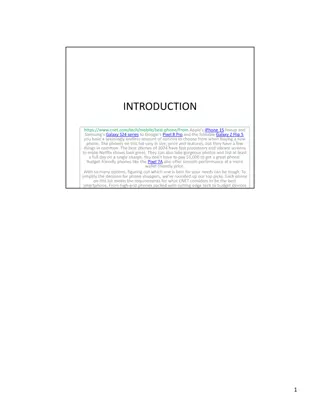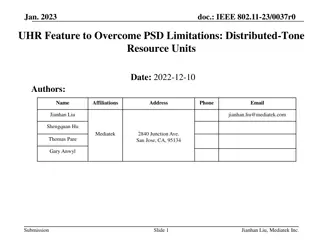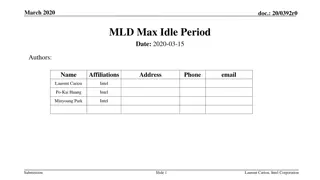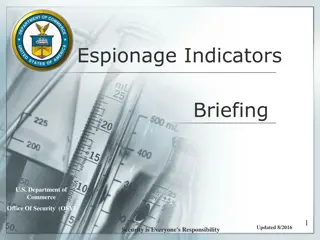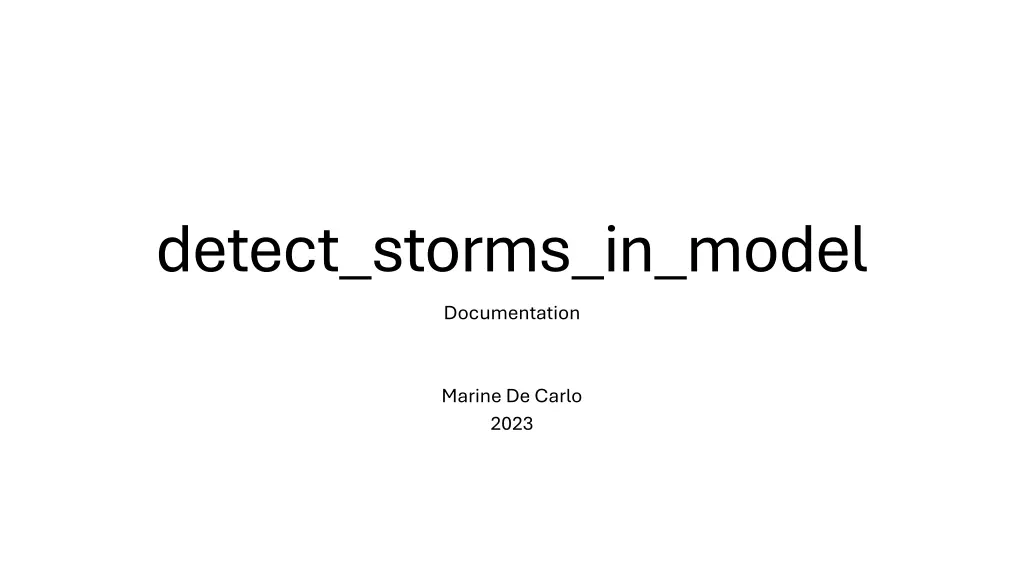
Effective Storm Detection and Tracking in Marine Environments
Explore the architecture and required packages for storm detection in marine environments using the provided Python code. Learn how to define parameters for detection and tracking, and run the code efficiently for accurate results.
Download Presentation

Please find below an Image/Link to download the presentation.
The content on the website is provided AS IS for your information and personal use only. It may not be sold, licensed, or shared on other websites without obtaining consent from the author. If you encounter any issues during the download, it is possible that the publisher has removed the file from their server.
You are allowed to download the files provided on this website for personal or commercial use, subject to the condition that they are used lawfully. All files are the property of their respective owners.
The content on the website is provided AS IS for your information and personal use only. It may not be sold, licensed, or shared on other websites without obtaining consent from the author.
E N D
Presentation Transcript
detect_storms_in_model Documentation Marine De Carlo 2023
Architecture of thefolder The src - detect_storms_in_model.py - linkStorms_models.py - detection_code/ __init__.py params_detect.py storms_functions_detect.py storms_functions_tracking.py storms_functions_io.py storms_functions_geo.py src folder contains:
Neededpackagesinenvironment Packages to be installed: Matplotlib - Pandas - Numpy - Scipy - Xarray - Netcdf4 - H5netcdf - To use the environment in jupyter : '<whatever_snake> install ipykernel jupyter' - python -m ipykernel install --user --name=<ENV_name> --display-name=<ENV_name_to_be_displayed> -
Params_detect.py 3 params to define Hslevelsused fordetection (seeslide 9): Params_detect.py contains yourparameters, both paths and detection criterion. Path parameters: Nb_CPU : nb of cpu that you want to allow for multiprocessing if any (limitation max to avoid memory issue) isWW3 (depending on how is the data saved =1 is monthly, =0 is daily) PATH : where are the input files stored(without year ormonth info) FORMAT_IN* : remaining of the path = partcontaining thetemporalinfo + filename PATH_SAVE_detect,PATH_SAVE_tracking : Pathswhere to savethe results of the code FORMAT_OUT_detect*, FORMAT_OUT_tracking*: file generic name for saving results filedist2coast: path to nc file containing the distance to coast grid. swh_crit_max, dswh_crit,min_swh => swh_levels= np.arange(min_swh, swh_crit_max + dswh_crit, - dswh_crit) - Parameters for detection criterion: - amp_thresh : minimum value of the normalized prominence of the peak for a region to be detected as storm default: 1./5 - min_area : minimum area for a region to be detected as storm, in km2 default : 500 - area_forgotten_ratio : minimum ratio of area fora regionto become a "forgotten" stormand be saved as a storm (see slide 10) default : 0.2 Parameter for tracking: threshold_dist : distancemax for a storm between2 timesteps, in km default : 400 - - - - - - - *write generic name with YYYY and MM(and DD for input files when isWW3 ==0)
How torun To run the code : 1) Activate your python environment 2) Go to the src folder 3) Check the params_detect.py file (update with yourdata, folders etc) 4) Type the instruction (e.g.) python detect_storms_in_model.py -s 0 -y 2023 -Y 2023 m 1 M 2 Amongst the options the ' s' (step) one is mandatory. Here are the different subroutinerun for each step (for the difference betweeninternal tracking and transition tracking, see slide 12) Step Step Number Number 0 0 1 1 2 2 111 111 110 110 11 11 Detection Internal tracking Transition tracking
How torundetect_storms_in_model.py python detect_storms_in_model.py -h usage: detect_track_storms [-h] [-y YEAR] [-m MONTH] [-Y FINAL_YEAR] [-M FINAL_MONTH] [-s {0,1,2,11,111,110}] [-r] [-R] [--multiprocessing] options: -h, --help -y YEAR, --year YEAR Chose the year for processing -m MONTH, --month MONTH Chose the month for processing -Y FINAL_YEAR, --final_year FINAL_YEAR Chose the final year to take into account -M FINAL_MONTH, --final_month FINAL_MONTH Chose the final month to take into account -s {0,1,2,11,111,110}, --step {0,1,2,11,111,110} Choose the step for applying the calculation process. 0: detect_only | 1: file_internal_track_only | 2: transition_track_only | 111 : all_steps | 110: detect and file internal track steps (no transition between files track) | 11 : all_tracking_steps -r, --reprocess Force a reprocessing for the detection step : existing files will be deleted and re computed -R, --reprocess_tracking Force a reprocessing for the tracking steps : existing files will be deleted and re computed --multiprocessing Use multiprocessing to run the code show this help message and exit
Function'run_detection' (step 0) Loop over months (1 filefor WW3 orconcatenation of days for ERA5), For each month, there is a loopover time steps: either using the python package multiprocessing orusinga classicalfor-loop (depending on the '--multiprocessing' optionof the code) For each time step the function'get_storm_by_timestep' is applied. The results are then appended, concatenated and saved into 1 dataset per month. => The Path and name format for saving these dataset are defined in params_detect.py as 'PATH_SAVE_detect' and 'FORMAT_OUT_detect'. The final filename is os.path.join(PATH_SAVE_detect,FORMAT_OUT_detect)
Function 'get_storm_by_timestep' Inputs : - - - ds0 ds0 : xarray DataSet with coordinates'longitude', 'latitude' and 'time' levels levels for Hs screening:np.array() in decreasing order (see slide 9). Defined in params_detect.py amp_thresh amp_thresh : relative amplitude thresholdratio criterion to select regionas storm. Defined in params_detect.py (linked to condition (max(interior) - min(exterior))/max(interior)>=amp_thresh) min_area min_area : criterion forminimum size of a storm.Defined in params_detect.py area_forgotten_ratio area_forgotten_ratio: criterion forsaving a storm close to another one. Defined in params_detect.py plot_output plot_output=False : /!\returns the handles for the results figure plot_example plot_example=False - - - - Params have been removedbut can stillbe of interest (Defined in params_detect.py ) - Npix_min : for criterionon number of pixels per selection(oldversion of eddy_area_within_limits) - cte.d_thresh_min, cte.d_thresh_max => conditionis_large_enough (criterion on'shape').
Function 'get_storm_by_timestep' Outputs : _results is a xarray dataset => the 'storms_by_t'coordinateis the number ofstorm detected by timestep the 'areastorm' is given inkm2. Ifoptionplot_output plot_output is True: the handle to the figure is also returned - -
Function 'get_storm_by_timestep' For each level in levels - 'labelisation' of regionsabove threshold is done - each region is studied: if criterions are matched => storm is saved ! levels (in decreasing order) The Hs map is duplicated fromlon= [-180;180] to lon=[- 180;360] => to avoiddetection issues around 180
Function 'get_storm_by_timestep' Criterions for saving storms: eddy_area_within_limits: the area of the region must be > min_area has_internal_max: the maximumof the region must be properlyinside and not on its edge is_tall_storm: the difference between the max of the region and the mean of itsedgeshouldbehigher than amp_thresh *max(region) Specialcriterionsexists to deal with problematic situationssuch as : 1. At previous level, both regions red and orange have been detected 2. However, at previous level, only the orange regions has been saved, 3. At current level, the detection gives the black region => criterionto see if the red region isa 'forgotten_storm' or not ? OR Are there 2 storms or justone ? The criterion compares the param area_forgotten_ratio the 'forgotten' region (here the red region) and the larger of the saved regions area (here the orange region) inside the new region (here the black region). area_forgotten_ratio to the area ratio between
Function 'get_storm_by_timestep' The functiongets a map of "detected" or "saved" regions The get_storm_info_from_savemapfunction is applied to extract the main information: Number of storms detect Index ofthe storm (called 'regions') Hs max in the region Area ofthe regionin km2 'lon_max', 'lat_max' :coordinates ofHs max (same as dataset coordinates longitude, latitude) - - - - -
Trackingfunctions (steps 1and 2) For efficiency, 2 types or tracking are done: The first one is called internal tracking inside inside one month file. Can be performed using multiprocessing For each file, the storms numbergoes from 0 to N => Corresponds to Corresponds to step step 1 ( internal tracking : the tracking is performed from one timestep to the next - 1 (file_internal_track_only file_internal_track_only) ) and included in steps 111, 110 and 11. and included in steps 111, 110 and 11. The secondtype is calledtransition tracking storms between the firstdate of one month and the last date of the previousone, and rename the storms Mustbe performed sequentially(best with the entire sequence) For each file, the storms numbergoes from Ni to Ni+1 => Corresponds to step 2 ( Corresponds to step 2 (transition_track_only transition_track_only) ) and included in steps 111 and 11. transition tracking as it makes the transition between files, tracking - and included in steps 111 and 11.
Tracking functions For both tracking types, the comparison is directlymade between time step T and T-1. A for-loop over all storms from timestep T is performed: Foreach storm st intime step T, the function'one_storm_vs_old_storms' is applied. This function: 1) Computes the distance (haversine function) between the storm stand all storms (st_oldi) from T-1 2) The couples (st, st_oldi) with distance< threshold_distare considered potential_points. 3) Ifthere is land between st and st_oldi => the couple is removed from potential_points 4) From the remainingpotential_points, the couple (st, st_oldi) with the minimaldistance is selected, if there is no remaining potential_points st is flagged as not_linked. If various storms stare linkedto the same st_oldi => only the st with the min distance is kept, the othersare flaggedas not_linked. For each storm stin timestep T, ifthere is a selectedcouple(st,st_oldi)=> assign to st the number of st_oldi else (if not_linked)=> the st isconsidered anew storm and assigned a new number




